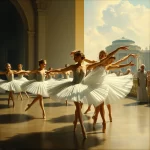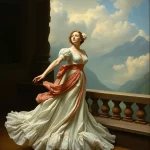Ballet: Napoli (Edvard Helsted, Holger Simon Paulli, 1842)

Introduction
Ballet: Napoli, also known as The Fisherman and His Bride, is a celebrated ballet choreographed by August Bournonville with music composed by Edvard Helsted and Holger Simon Paulli. Premiering on March 29, 1842, at the Royal Danish Theatre in Copenhagen, this ballet is a quintessential example of the Romantic era’s influence on dance. The ballet tells the story of a young Italian fisherman, Gennaro, and his love for Teresina, set against the picturesque backdrop of Naples. The narrative explores themes of love, faith, and the triumph of good over evil.
Historical Background
Creation and Development
The creation of Napoli occurred during a period of significant cultural and artistic development in Europe. The early 19th century was marked by the Romantic movement, which emphasized emotion, nature, and individualism. Bournonville, a prominent figure in the Danish ballet scene, was inspired by his travels to Italy, particularly Naples, which provided the vibrant setting for the ballet. The collaboration between Bournonville and composers Edvard Helsted and Holger Simon Paulli was crucial in bringing this vision to life. The ballet also drew inspiration from Italian folklore and literature, blending these elements into a cohesive and enchanting narrative.
Premiere and Reception
Napoli premiered on March 29, 1842, at the Royal Danish Theatre in Copenhagen. The initial reception was overwhelmingly positive, with both critics and audiences praising the ballet’s lively choreography, engaging story, and beautiful music. The ballet quickly became a staple of the Royal Danish Ballet’s repertoire and has been revived numerous times since its premiere. Notable early performances include those by Lucile Grahn and August Bournonville himself, who played the roles of Teresina and Gennaro, respectively.
Synopsis of the Ballet
Act I Summary
The ballet opens in a bustling square in Naples, where fishermen and townsfolk go about their daily lives. Gennaro, a young fisherman, is in love with Teresina, the daughter of a local shopkeeper. Despite their mutual affection, Teresina’s mother disapproves of their relationship due to Gennaro’s modest means. The act culminates in a dramatic storm at sea, during which Teresina is swept away, leaving Gennaro devastated.
Act II Summary
Act II transports the audience to the Blue Grotto, an underwater realm ruled by the sea spirit Golfo. Teresina, now under Golfo’s spell, has forgotten her past life. Gennaro, determined to rescue her, ventures into the grotto with the help of a monk. Through a combination of bravery and faith, Gennaro breaks Golfo’s spell, and Teresina regains her memory. The act ends with their joyful reunion.
Act III Summary
The final act returns to Naples, where the townsfolk are celebrating a festival. Gennaro and Teresina’s love is finally accepted by her mother, and the couple is joyfully reunited with their community. The ballet concludes with a grand celebration, featuring lively dances and a reaffirmation of love and faith.
Finale
The conclusion of Napoli is significant as it reinforces the themes of love, faith, and community. The joyous festival and the acceptance of Gennaro and Teresina’s love symbolize the triumph of good over adversity, a common motif in Romantic-era ballets.
Musical Composition
Composer’s Role
Edvard Helsted and Holger Simon Paulli played pivotal roles in the creation of Napoli‘s score. Helsted, a Danish composer, was known for his ability to blend traditional folk melodies with classical music, while Paulli brought a rich orchestral texture to the ballet. Their collaboration resulted in a score that perfectly complements Bournonville’s choreography, enhancing the narrative and emotional depth of the ballet.
Musical Themes and Motifs
The music of Napoli is characterized by its lively rhythms and melodic richness. Recurring themes and leitmotifs are used to represent characters and emotions, such as the love theme for Gennaro and Teresina. The music enhances the narrative by reflecting the changing moods and settings, from the bustling streets of Naples to the mystical Blue Grotto.
Famous Recordings and Performances
Several recordings of Napoli‘s music have been made over the years, capturing the ballet’s vibrant score. Notable performances include those by the Royal Danish Ballet, which has maintained the ballet as a key part of its repertoire. These recordings and performances have helped to preserve and popularize the ballet’s music for contemporary audiences.
Choreography and Dance
Choreographer’s Vision
August Bournonville’s vision for Napoli was to create a ballet that celebrated the joy of life and the power of love. His choreography is known for its lightness, grace, and intricate footwork, reflecting the influence of the Romantic era. Bournonville’s style emphasizes natural movement and expressive storytelling, making Napoli a timeless piece that continues to captivate audiences.
Signature Dance Numbers
Key dance numbers in Napoli include the Pas de Deux between Gennaro and Teresina, which showcases their love and connection. The Tarantella, a lively folk dance, is another highlight, reflecting the vibrant culture of Naples. These dances are not only technically demanding but also rich in character and emotion, bringing the story to life through movement.
Notable Interpretations
Over the years, different productions of Napoli have brought unique interpretations to Bournonville’s choreography. Some have emphasized the ballet’s folkloric elements, while others have focused on its romantic and dramatic aspects. These variations demonstrate the versatility and enduring appeal of Bournonville’s work.
Characters and Roles
Main Characters
- Gennaro: A young fisherman who is deeply in love with Teresina. His bravery and faith are central to the story.
- Teresina: The daughter of a shopkeeper, she is spirited and loving. Her journey from being lost at sea to reuniting with Gennaro forms the core of the ballet.
- Golfo: The sea spirit who enchants Teresina. He represents the obstacles that Gennaro must overcome.
Supporting Characters
- Teresina’s Mother: Initially disapproves of Gennaro but eventually accepts their love.
- The Monk: A wise figure who helps Gennaro rescue Teresina.
- Townsfolk: They add to the vibrant atmosphere of Naples and participate in the final celebration.
Famous Dancers
Notable dancers who have portrayed these roles include Lucile Grahn as Teresina and August Bournonville as Gennaro. In more recent times, dancers from the Royal Danish Ballet, such as Nikolaj Hübbe and Silja Schandorff, have brought these characters to life with their exceptional performances.
Cultural and Artistic Impact
Influence on Ballet and Dance
Napoli has had a significant influence on ballet and dance, particularly within the Danish ballet tradition. Bournonville’s choreography has inspired generations of dancers and choreographers, contributing to the development of ballet as an art form. The ballet’s emphasis on storytelling and character-driven dance has become a hallmark of the Bournonville style.
Cultural Significance
The ballet’s depiction of Italian culture and folklore has made it a beloved piece in the repertoire of many ballet companies. Its themes of love and faith resonate with audiences, making it a timeless work that continues to be relevant. Napoli has also been adapted into various forms, including film and theater, further cementing its place in popular culture.
Legacy and Revivals
Napoli has been revived numerous times since its premiere, with each production bringing new interpretations and insights. Major revivals by the Royal Danish Ballet have kept the ballet alive for contemporary audiences, while modern adaptations have introduced it to new generations. The ballet’s enduring popularity is a testament to its artistic and cultural significance.
Iconic Productions
Historic Productions
Historic productions of Napoli include the original 1842 premiere at the Royal Danish Theatre, which set the standard for future performances. Key figures involved in these early productions include August Bournonville and Lucile Grahn, whose portrayals of Gennaro and Teresina became iconic.
Contemporary Productions
Recent productions of Napoli have brought fresh perspectives to the ballet while staying true to Bournonville’s vision. Contemporary choreographers have explored new interpretations of the characters and story, while advancements in set and costume design have enhanced the visual appeal of the ballet.
Production Design
The production design of Napoli plays a crucial role in bringing the story to life. Set designs often feature picturesque depictions of Naples and the mystical Blue Grotto, while costumes reflect the vibrant culture of the region. Lighting design is used to create mood and atmosphere, enhancing the overall experience for the audience.
Critical Reception and Reviews
Initial Critical Response
At the time of its premiere, Napoli received glowing reviews from critics, who praised its lively choreography, engaging story, and beautiful music. The ballet was seen as a triumph for Bournonville and the Royal Danish Ballet, solidifying their reputation in the world of dance.
Modern Reviews
Contemporary critics continue to praise Napoli for its timeless appeal and artistic excellence. The ballet is often highlighted for its intricate choreography and emotional depth, making it a favorite among both audiences and dancers. Its relevance today is attributed to its universal themes and the enduring legacy of Bournonville’s work.
Fun Facts and Trivia
Behind-the-Scenes Stories
One interesting anecdote from the production of Napoli involves Bournonville’s travels to Italy, where he drew inspiration for the ballet. His experiences in Naples, including witnessing local festivals and traditions, greatly influenced the ballet’s setting and atmosphere.
Notable Performers
Famous dancers associated with Napoli include Lucile Grahn, who originated the role of Teresina, and August Bournonville, who played Gennaro. In more recent times, dancers such as Nikolaj Hübbe and Silja Schandorff have brought these characters to life with their exceptional performances.
Trivia
- Napoli is one of the few ballets from the Romantic era that has remained largely unchanged in its choreography.
- The ballet’s Tarantella dance is based on a traditional Italian folk dance believed to cure the bite of a tarantula spider.
- Bournonville’s use of everyday characters and settings was innovative for its time, breaking away from the more fantastical themes common in other ballets.
Conclusion
Summary of the Ballet’s Importance
Napoli is a significant work in the world of ballet, celebrated for its lively choreography, engaging story, and beautiful music. It has had a lasting impact on the development of ballet as an art form and continues to be a beloved piece in the repertoire of many ballet companies.
Final Thoughts
Reflecting on Napoli, it is clear why this ballet has endured for over a century. Its themes of love, faith, and community resonate with audiences, while Bournonville’s choreography and the beautiful score by Helsted and Paulli continue to captivate dancers and viewers alike. For those who have not yet experienced Napoli, it is highly recommended to watch a performance or listen to the score to appreciate its timeless beauty.
FAQ
What is the central theme of this ballet?
The central theme of Napoli is the power of love and faith to overcome adversity.
Who are the main characters in this ballet?
The main characters are Gennaro, a young fisherman; Teresina, his beloved; and Golfo, the sea spirit.
What is the most famous dance number in this ballet?
The Tarantella is one of the most famous dance numbers in Napoli, known for its lively and energetic choreography.
How long does a typical performance of this ballet last?
A typical performance of Napoli lasts approximately two hours, including intermissions.
Are there any modern adaptations of this ballet?
Yes, there have been several modern adaptations and revivals of Napoli, each bringing new interpretations to the classic ballet.
Why is this ballet considered important in the history of dance?
Napoli is considered important due to its innovative choreography, engaging narrative, and its role in the development of the Bournonville style, which has had a lasting influence on ballet.





